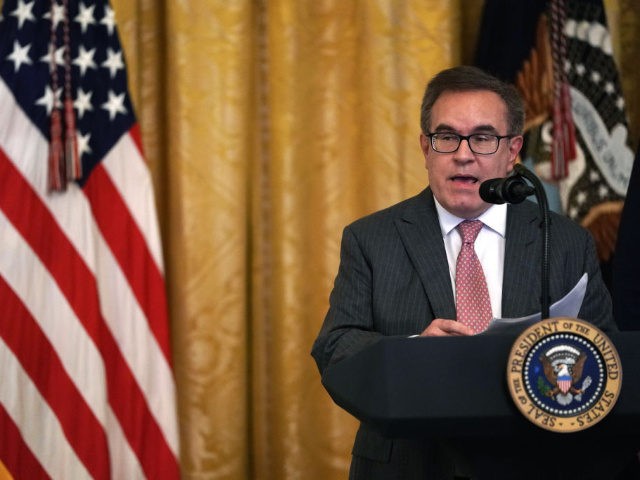The Environmental Protection Agency (EPA) released its annual “Our Nation’s Air” report on air quality on Wednesday, which documents how air quality continues to improve across America, dating back to the amended Clean Air Act of 1970.
“One of America’s great but untold environmental success stories is that we have made — and continue to make — great improvements in our air quality, thanks largely to state and federal implementation of the Clean Air Act and innovation in the private sector,” EPA Administrator Andrew Wheeler said in the announcement of the report’s release.
“Emissions of all key air pollutants dropped between 2016 and 2018, and lead and sulfur dioxide concentrations dropped by double-digit percentages during the same period,” Wheeler said.
“The U.S. is a global leader in clean air progress, and we’ve proven that we can protect the environment while growing our economy,” he continued.
“The report released [Tuesday] shows that, between 1970 and 2018, the combined emissions of six key pollutants dropped by 74 percent, while the U.S. economy grew 275 percent,” the press release announcing the report stated.
Some findings of the report include:
From 2016 to 2018, emissions of key air pollutants continued to decline:
- Nitrogen Oxides (NOx) down 8.7 percent
- Particulate Matter 2.5 (PM 2.5) down 1.9 percent
- Particulate Matter 10 (Including lead) (PM 10) down 1.2 percent
- Sulfur Dioxide (SO2) down 7.8 percent
- Carbon monoxide (CO) down 7.2 percent
- Volatile Organic Compounds (VOC) down 3.3 percent
In addition, average concentrations of harmful air pollutants decreased considerably across our nation between 1990 and 2018:
- Ground-level ozone (8-hour) down 21 percent
- Fine Particulate Matter (annual) down 39 percent (from 2000)
- Coarse Particulate Matter (24-hour) down 26 percent
- Sulfur dioxide (1-hour) down 89 percent
- Nitrogen dioxide (annual) down 57 percent
- Lead (3-month average) down 82 percent (from 2010); and
- Carbon monoxide (8-hour) down 74 percent
“EPA examines long-term trends to track the nation’s progress in cleaning the air. Air quality concentrations can vary year to year, even as human-caused emissions continue to decline,” the press release stated. “Variations in weather and natural events such as dust storms and wildfires can have an impact on air quality in affected areas.”
“As a whole, human-caused emissions of the six common pollutants dropped in 2018, continuing the long-term trend,” the press release stated. “Despite this, the report shows that monitors in some areas logged increases in concentrations of particulate matter in the outdoor air, due in part to natural events such as wildfires.”
“The increases in these areas had a small, but noticeable, impact on the national average,” the press release stated.
But the little attention the media gave to the report does not provide the good news and instead claims the report contains bad news for Americans and air quality.
U.S. News and World Report took data from the report to provide the bad news in an article entitled, “EPA: Unhealthy Air Days Increased in 2018”:
The number of days with air pollution levels high enough to endanger elderly people or children increased last year, according to the Environmental Protection Agency.
The agency’s annual air quality report found that among 35 major U.S. cities last year, there were a combined 799 days when the air was unhealthy for “sensitive” groups, which the EPA said can include the elderly, children, and people with heart or respiratory diseases.
But the media outlet does not note that the increase is slight and that if those statistics are averaged for unhealthy air for sensitive groups in those 35 cities, it would mean poor air quality 22 days per year.
“Still, the trend of lower reported emissions but higher air pollutant concentrations raises questions,” the media outlet reported. “Even 2016 reported 97 fewer unhealthy air days than 2018, and that year was the hottest on record and experienced many wildfires.”
The media outlet linked to a NASA report released earlier this year that it said proved global warming is taking place.
Reuters also led its article by stating, “The number of unhealthy air days in major cities across the United States has risen sharply over the last two years.”
However, the EPA report shows increases in unhealthy days went up only slightly, from 721 in 2017 to 799 in 2018.
In 2012, the year Barack Obama won reelection, the number of unhealthy days was 1,296.
“Air and health advocates said the figures were nothing to celebrate,” Reuters reported.
The media outlet spoke with Paul Billings, senior vice president of the American Lung Association, who “warned that Trump administration efforts to roll back environmental rules to bolster economic growth raised the risk to air and water quality.”
Follow Penny Starr on Twitter.

COMMENTS
Please let us know if you're having issues with commenting.